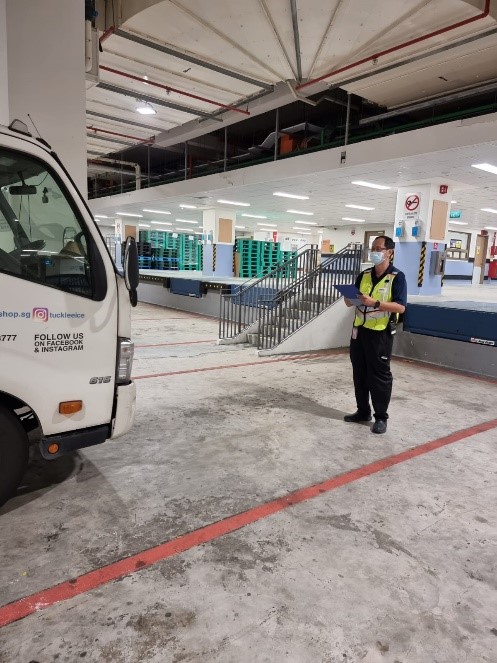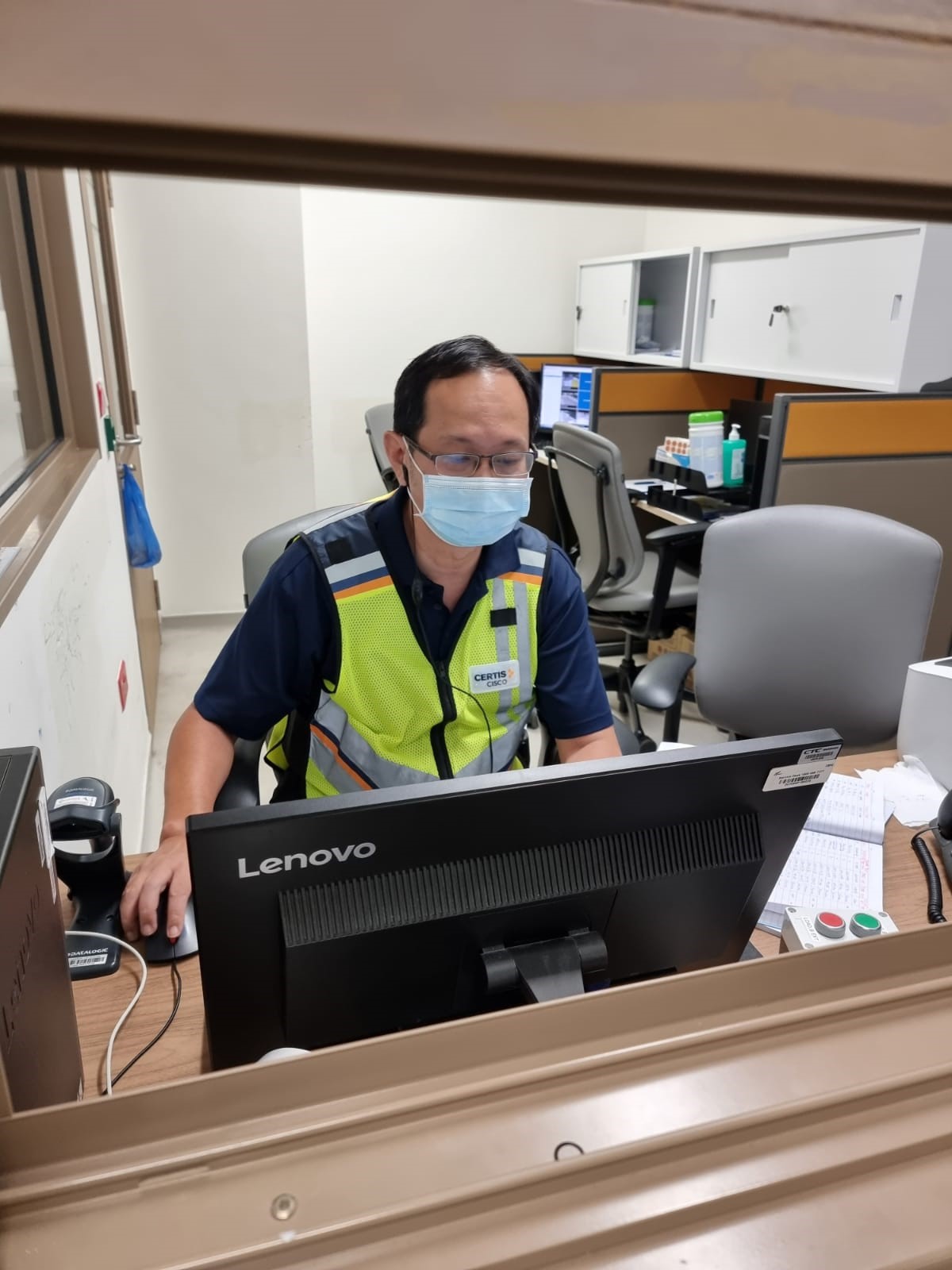As an integral part of campus operations, our security officers on SingHealth campuses play a crucial role in ensuring that patients receive efficient care in a safe and secure environment. But do you know what a typical day looks like for them?
Let’s join Mr Lam Wai Meng, a Certis Senior Security Officer deployed at Outram Community Hospital (OCH) on his daily routine to find out more!
8AM – 10AM
Mr Lam’s 12-hour shift begins with him receiving his deployment roster for the day. SingHealth’s Security Officers rotate their stations and tasks on an hourly basis, which relieves task fatigue and helps them keep alert throughout their shifts. With a quick check of his neatly pressed uniform and equipment – a walkie talkie and body camera – to make sure everything is working as expected, he heads off to the Loading Bay – his first station of the day – to oversee the loading and unloading of various logistics required in the institution, and standby for any possible activations at the basement floors.

It’s now 9am and time for the first station change. Mr Lam heads to the Drop-off & Pick-up Point and takes up the role of a traffic controller, ensuring that there is smooth traffic. At this hour, vehicles are constantly streaming in, but Mr Lam manages to keep things under control.

10AM – 12PM
Next up, clocking. During this hour, Mr Lam will patrol Levels 1 to 4, and clock-in at certain points throughout his route to indicate that the area is safe. While on patrol, he is on heightened alert, and will constantly be on the lookout for suspicious looking persons and articles, as well as uncooperative persons. Armed with
Argus, an officer support system, Mr Lam is able to efficiently report anything that is out of the ordinary, if any, to the Campus Security Command Centre for an appropriate response.
| “On the patrol”
Everyday around the clock, Security Officers are patrolling the campus, whether on foot in the buildings, or in vehicles on the roads!
For Security Officers deployed to patrol the perimeter and roads around SGH Campus, patrol vehicles help them get around fast and establish a presence to deter potential threats. With the launch of One SingHealth Security, additions and enhancements has been made to the existing fleet of patrol vehicles on SGH Campus, including the deployment of a patrol car sporting new livery for better visibility and High Capacity Quick Response Motorbikes for swift and effective response to incidents anywhere on campus. |
After three hours of being on his feet, it’s time for Mr Lam to take a well-deserved lunch break, to re-energise himself for the remainder of the day.
12PM – 2PM
After lunch, Mr Lam is back in action at the Loading Bay Office as he conducts access control. His main task here is to do checks on vendors and delivery personnel entering the building, followed by registering them and dispensing the appropriate visitor passes to them.
As a Security Officer in his late 50s, Mr Lam had to embrace new technologies, and pick up IT-related skills and competencies, which are now often required as an addition to the traditional security skillset.

Foot traffic in OCH increases around 1pm. Mr Lam now heads over to Lobby B for his next deployment, where he assists visitors and patients in navigating their way around the building. As safe management measures are in place during the COVID-19 pandemic, Mr Lam also ensures that visitors are checked in with TraceTogether, and that they have the appropriate passes and stickers.
To Mr Lam, deployments such as this are often a highlight of his day, as he enjoys interacting and helping others. One of his fondest memories was when an appreciative patient gave him a bottle of medicated ointment to relieve aches from being on his feet for such a long time!

2PM – 8PM
Halfway through his shift, Mr Lam has now experienced most of the unique deployments for the day. He now continues rotating stations hourly in this manner, throughout the various deployment stations.
Apart from emergencies that may crop up from time to time, which may see officers taking up additional tasks such as investigating and providing secure escort, another frequent activation for Security Officers is the first-line response to enforce staff and patient safety. The presence of Security Officers serves as a calming yet firm force in tense situations where patients are abusive or uncooperative with our medical staff. In some cases, where miscommunication due to language barriers occurs, Security Officers even double up as translators to defuse the situation. An average day as a Security Officer can be routine at times, but the value they add to healthcare cannot be overstated.
“Code Blue”One key role that Security Officers play is in responding swiftly to Code Blue Activations, a medical emergency where there is an urgent need to ensure that the medical teams will be able attend to the patient immediately. During such activations, Security Officers stationed nearby will swiftly jump into action, reaching the incident location within moments and keeping the path clear for medical staff and equipment – all within 5 minutes! Their swift response is crucial in enabling medical teams to gain unimpeded access to the patient, which ultimately improves patient outcomes. |
12 hours later, Mr Lam’s long day at work is now over, and he does a complete handover to his colleague on the night shift, before heading home to recharge and refuel for the next day.
“Working in healthcare security is rewarding as I get the opportunity to help out in crucial, and sometimes even life-saving operations. I feel the satisfaction in playing my part to keep our patients, visitors and staff safe every day. It is heart-warming to know that I might have made a difference in someone's life!”
- Mr Lam Wai Meng
While protecting any environment requires a certain skill set and training, guarding in a healthcare setting requires even more. Hospitals are emotionally charged environments, creating a complicated and layered landscape that must be navigated with sensitivity by well-trained and highly capable security professionals.
The role of a healthcare security officer is significantly more interactive than in other settings, as officers directly engage with patients, families, visitors and staff. Our security officers are not only the first touchpoint patients or visitors encounter when they enter SingHealth institutions, they are also the first to assist clinical staff, should the need arise.
With last week’s
One SingHealth Security launch, we hope to empower our Security Officers and teams with state of the art security technology so they can discharge their duties safely, efficiently, and with a new unified identity.
Tags:
;
;
;
;
Internal;
;
SingHealth;
Article;
Tomorrow's Medicine;
;
;
;
;
Tomorrow's Medicine
